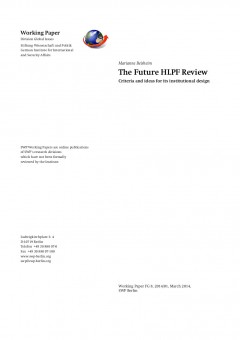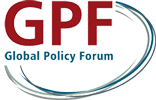
by Marianne Beisheim
From the Working Paper
[...] At the Rio+20 Conference in July 2012, the decision was made to create a new High-level Political Forum for Sustainable Development. Its aim would be to provide political leadership and guidance and a dynamic platform for regular dialogue, stocktaking, and agenda-setting — all to advance sustainable development. In September 2013, the new UN High-Level Political Forum on Sustainable Development (HLPF) was convened for the first time — it replaces the UN’s Commission on Sustainable Development (CSD). The HLPF will meet annually at the ministerial level under the auspices of the Economic and Social Council (ECOSOC) and, to enhance the political stature of the forum, will also be convened every four years for a period of two days at the level of the heads of state and government under the auspices of the General Assembly. In contrast to the CSD, membership in the HLPF is universal, which means that all Member States in the UN and its specialized agencies can participate.
According to its mandate, the HLPF is to provide “political leadership, guidance and recommendations” and to “follow up and review progress in the implementation of sustainable development commitments.” But how should it go about playing this role — and how could it do so more effectively than the CSD? An important element of its work will be the review process envisioned by the HLPF mandate and starting in 2016. [...] The precise structure of the follow- up process, however, is still not clear. [...]
Above all, the new review mechanism is supposed to monitor and follow up the implementation of the still-to-be-determined post-2015 agenda and goals for sustainable development. It is planned that in September 2014, negotiations over the Post-2015 Development Agenda (to succeed the MDGs) will be merged with those on the Sustainable Development Goals (SDGs), which have been debated since the Rio+20 Conference. Then, up to the UN General Assembly in September 2015, negotiations are to take place on a single set of post-2015 goals and targets. [...]
The future review process should [...] take a differentiated approach as called for by the Outcome Document of the Rio+20 Conference. Sustainable development goals should be “global in nature and universally applicable to all countries, while taking into account different national realities, capacities and levels of development and respecting national policies and priorities.” Up to now, however, it has not been determined what exact form this differentiation will take. [...]
The discussion up to this point leads to the following criteria that the future review mechanism should fulfill:
| Criterion | Measured by |
|
Broadly accepted |
Establishment and active use of the review, |
|
Includes incentives and supportive elements |
Provides access to funds for implementation and capacity building |
|
Participatory |
Level of inclusion of regional, national, and local stakeholders and major groups |
|
Subsidiary and differentiated |
Bottom-up structure and differentiation by national priorities and capacities |
|
Feasible with reasonable effort |
Organizational, time, and budgetary needs |
|
Effective in promoting implementation |
Good outcomes or points of critique (in the past) |
Based on these criteria for an effective review mechanism, the remainder of this paper will analyze existing review processes (see Section 2) and evaluate their advantages for the new HLPF Review. The third and final section then outlines a proposal for a multi-level review process that integrates selected building blocks (modeled after existing review mechanisms). The proposed model presents only one – quite ambitious – way to combine these building blocks (see Fig. 1); other options may be more practical, but they may entail a trade-off between the feasibility and seriousness of the review process.
